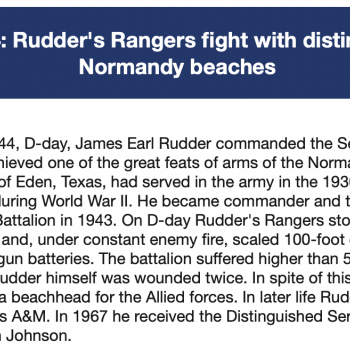Rudder, James Earl
- Eden, Texas, Concho County, United States
Military Information:
- US Army
- Bronze Star Medal
- Silver Star
- Retired Military
- Vietnam Veteran
- Rank 08
- WWI Veteran
- Distinguished Service Cross
- Deceased
- WWII Veteran
- Cold War
- Legion of Merit
- Army Commendation Medal
- TVHOF Class 2020
- QR Code
- TVHOF Patriot Award
- 2 War Veteran
- Croix de Guerre
- Bronze Oak Leaf Cluster
- Major General (2 Star)
- 1-Alpha List
Bio:
Since his death in 1970, an annual service has been held in Normandy, France, in his honor.
Born May 6, 1910
Eden, Texas
Died March 23, 1970 (aged 59)
Houston, Texas
Allegiance United States of America
Service/branch United States Army
Years of service 1941–1967
Rank US-O8 insignia.svg Major general
Battles/wars World War II
D-Day Ranger assault at Pointe du hoc
Battle of Hürtgenwald
Battle of the Bulge
Cold War
Awards Distinguished Service Cross
Distinguished Service Medal
Silver Star
Legion of Merit
Bronze Star Medal (2)
James Earl Rudder (May 6, 1910 – March 23, 1970) was a United States Army Major General. As a Lieutenant Colonel he commanded the historic Pointe du Hoc battle during the Invasion of Normandy. He also commanded the US Troops at the Battle of the Hürtgen Forest and led a series of delaying actions and ambushes during the Battle of the Bulge. General Rudder also at various times served as Texas Land Commissioner, the 16th president of Texas A&M University, third president of the Texas A&M University System, mayor of Brady, Texas, and a high school and college teacher and coach.
Texas historical marker in the German observation bunker at Pointe du Hoc
After graduation from Texas A&M, Rudder had been commissioned a second lieutenant of infantry in the United States Organized Reserve Corps. After being called into active duty in 1941, Rudder took part in the D-Day landings as commanding officer of the United States Army's 2nd Ranger Battalion.
His U.S. Army Rangers stormed the beach at Pointe du Hoc, scaling 100-foot (30-meter) cliffs under enemy fire to reach and destroy a German gun battery. The battalion's casualty rate for this perilous mission was greater than 50%. Rudder himself was wounded twice during the course of the fighting. Though there was fierce resistance the Germans had removed the main armament from Pointe du Hoc in April 1944, and secretly constructed Maisy battery as the main heavy artillery position in the sector which was left operational. In spite of this Rudder ordered his men to dig in and they fought off German counterattacks for two days until relieved.[1] His men and he helped to successfully establish a beachhead for the Allied forces. The siege was replicated in the 1962 epic film The Longest Day.[2]
Seven months later, Rudder was re-assigned in the middle of an assault to the 109th Infantry Regiment, which saw key service in the Battle of the Bulge. Rudder earned military honors including the Distinguished Service Cross, Bronze Star with Oak Leaf Cluster, Purple Heart with Oak Leaf Cluster, French Legion of Honor with Croix de Guerre and Palm, and Order of Leopold (Belgium) with Croix de Guerre and Palm. He was a full colonel by the war's end and was promoted to brigadier general of the United States Army Reserve in 1954 and major general in 1957.
https://en.wikipedia.org/wiki/James_Earl_Rudder
https://www.findagrave.com/memorial/17137858/james-earl-rudder



